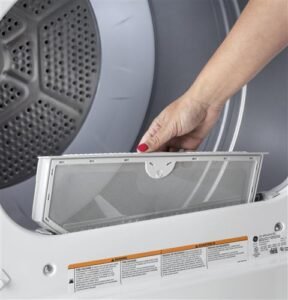
You see, appliances like dryers are pretty smart these days. They’re equipped with sensors and programs that monitor their performance. When something goes awry, instead of just sputtering to a stop, they flash an error code like E3. Think of it as your dryer’s way of sending you a text message: “Hey, I need a little help here.” In this case, the E3 error code typically means there’s a problem with the temperature sensor or the heating element, crucial parts for your dryer to work properly.
Understanding the E3 Error Code
The E3 error code is essentially your GE dryer’s way of waving a red flag and saying, “Help! Something’s wrong with my heating mechanism!” To simplify, it’s like when a car’s engine warning light comes on – you know you’ve got to check under the hood. With an E3 error, the issue is usually linked to the dryer’s internal temperature control. The dryer might be overheating or not heating at all, depending on whether the temperature sensor or the heating element is malfunctioning.
Now, why does this matter? Well, the heating element is like the heart of your dryer. It’s what makes the air hot, so your clothes come out dry and warm. If it’s not working, your clothes might still be soggy after a full cycle. On the flip side, if it’s overheating, you’ve got a potential safety concern. The temperature sensor is the part that tells the dryer when to heat up and when to cool down, keeping everything balanced and safe.
If you’re seeing the E3 error code, it’s crucial to first stop using the dryer to prevent any potential damage. Just like how you wouldn’t keep driving a car with the oil light on, it’s wise to pause and assess. Understanding this part of your dryer’s ‘text message’ system helps you know when it’s time to roll up your sleeves or call in an expert.
Common Causes of E3 Error Code
So, what usually causes the E3 error code to pop up? There are a few culprits that tend to be the usual suspects. The most common issue is a faulty temperature sensor. Over time, sensors can wear out, get damaged, or become less accurate. Imagine trying to bake a cake with a thermometer that keeps giving you the wrong temperature – it’s frustrating and ineffective.
Another possibility is the heating element itself might be damaged or covered with lint build-up. Similar to how a clogged chimney affects a fireplace, lint can prevent your dryer’s heating element from working efficiently. This could either make your dryer too hot, leading to the risk of overheating, or too cold, leaving you with damp clothes.
Finally, electrical issues or wiring problems can also trigger the E3 error. Appliances are full of complex wiring, and sometimes these connections can loosen or fray. This is like having a string of Christmas lights where a single burned-out bulb makes the whole thing stop working. If your dryer’s wiring isn’t intact, it can’t communicate properly, resulting in error codes.
Addressing and Fixing the Error
Alright, so your dryer’s flashed the E3 error code, and you’ve got a pretty decent idea of why it might be happening. What’s next? First, it’s always a good idea to turn off the dryer and unplug it. This is for safety – you don’t want to be poking around with live electrical currents. Once it’s off, take a peek inside the lint trap and vent. Clearing any lint build-up can sometimes solve minor heating issues right away.
If you’re comfortable doing so, you could check the condition of the heating element and temperature sensor yourself. Remember, these components are often located behind or beneath panels, so you might need a screwdriver handy. However, if this feels like diving into uncharted waters, there’s no shame in calling a professional. In fact, if you suspect electrical issues or substantial component damage, a technician is your best bet.
To prevent future occurrences, regular maintenance is key. Checking and cleaning your dryer’s lint traps and vents routinely can do wonders. Just like you’d change the oil in your car, keeping tabs on your dryer’s health can keep it running smoothly for years to come. If repairs seem daunting, routine inspections by a professional can nip potential issues in the bud, saving you stress and money down the line.
Next Steps and Prevention Tips
Once you’ve managed to fix the E3 error, it’s time to think about future prevention. Consistent care and attention go a long way. Make a habit of cleaning the lint trap after every use, and schedule deep cleaning sessions for your dryer ducts and vents every six months or so. It’s a bit like spring cleaning your closet – it might seem tedious, but it’s incredibly rewarding when your dryer performs without a hitch.
Beyond maintenance, pay attention to how your dryer is performing. Listen for unusual sounds, monitor drying times, and be vigilant for any other unusual error codes. Being proactive and catching issues early can prevent them from escalating. Just like with our cars, a little preventive maintenance can help avoid major repairs.
In conclusion, the E3 error code on your GE dryer is more than just a random set of characters. It’s a specific message from your appliance, calling for your attention and action. By understanding this code, addressing the root causes, and taking preventive measures, you can keep your dryer humming along smoothly, ensuring your laundry days are as hassle-free as possible.